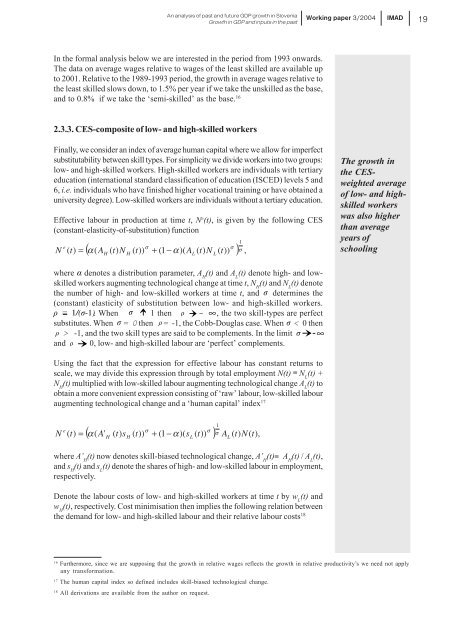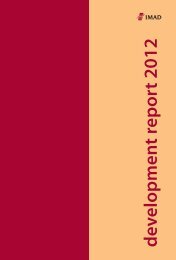Working papers published by IMAD ISSN: 1318-1920 ... - UMAR
Working papers published by IMAD ISSN: 1318-1920 ... - UMAR
Working papers published by IMAD ISSN: 1318-1920 ... - UMAR
You also want an ePaper? Increase the reach of your titles
YUMPU automatically turns print PDFs into web optimized ePapers that Google loves.
An analysis of past and future GDP growth in Slovenia<br />
Growth in GDP and inputs in the past<br />
<strong>Working</strong> paper 3/2004<br />
<strong>IMAD</strong><br />
19<br />
In the formal analysis below we are interested in the period from 1993 onwards.<br />
The data on average wages relative to wages of the least skilled are available up<br />
to 2001. Relative to the 1989-1993 period, the growth in average wages relative to<br />
the least skilled slows down, to 1.5% per year if we take the unskilled as the base,<br />
and to 0.8% if we take the ‘semi-skilled’ as the base. 16<br />
2.3.3. CES-composite of low- and high-skilled workers<br />
Finally, we consider an index of average human capital where we allow for imperfect<br />
substitutability between skill types. For simplicity we divide workers into two groups:<br />
low- and high-skilled workers. High-skilled workers are individuals with tertiary<br />
education (international standard classification of education (ISCED) levels 5 and<br />
6, i.e. individuals who have finished higher vocational training or have obtained a<br />
university degree). Low-skilled workers are individuals without a tertiary education.<br />
Effective labour in production at time t, N e (t), is given <strong>by</strong> the following CES<br />
(constant-elasticity-of-substitution) function<br />
N<br />
e<br />
( t)<br />
=<br />
1<br />
σ<br />
σ<br />
( α ( A ( t)<br />
N ( t))<br />
+ (1 − α )( A ( t)<br />
N ( t))<br />
) σ ,<br />
H<br />
H<br />
L<br />
L<br />
The growth in<br />
the CESweighted<br />
average<br />
of low- and highskilled<br />
workers<br />
was also higher<br />
than average<br />
years of<br />
schooling<br />
where á denotes a distribution parameter, A H<br />
(t) and A L<br />
(t) denote high- and lowskilled<br />
workers augmenting technological change at time t, N H<br />
(t) and N L<br />
(t) denote<br />
the number of high- and low-skilled workers at time t, and ó determines the<br />
(constant) elasticity of substitution between low- and high-skilled workers.<br />
ñ = 1/(ó-1) . When ó 1 then ñ - ∞, the two skill-types are perfect<br />
substitutes. When ó = 0 then ñ= -1, the Cobb-Douglas case. When ó < 0 then<br />
ñ > -1, and the two skill types are said to be complements. In the limit ó ’!-∞–<br />
and ñ ’! 0, low- and high-skilled labour are ‘perfect’ complements.<br />
Using the fact that the expression for effective labour has constant returns to<br />
scale, we may divide this expression through <strong>by</strong> total employment N(t) a ≡ N L<br />
(t) +<br />
N H<br />
(t) multiplied with low-skilled labour augmenting technological change A L<br />
(t) to<br />
obtain a more convenient expression consisting of ‘raw’ labour, low-skilled labour<br />
augmenting technological change and a ‘human capital’ index 17<br />
N<br />
e<br />
( t)<br />
=<br />
1<br />
σ<br />
σ<br />
( α(<br />
A'<br />
( t)<br />
s ( t))<br />
+ (1 − α)(<br />
s ( t))<br />
) σ A ( t)<br />
N(<br />
t),<br />
H<br />
H<br />
where A’ H<br />
(t) now denotes skill-biased technological change, A’ H<br />
(t) ≡ A H<br />
(t) / A L<br />
(t),<br />
and s H<br />
(t) and s L<br />
(t) denote the shares of high- and low-skilled labour in employment,<br />
respectively.<br />
Denote the labour costs of low- and high-skilled workers at time t <strong>by</strong> w L<br />
(t) and<br />
w H<br />
(t), respectively. Cost minimisation then implies the following relation between<br />
the demand for low- and high-skilled labour and their relative labour costs 18<br />
L<br />
L<br />
16<br />
Furthermore, since we are supposing that the growth in relative wages reflects the growth in relative productivity’s we need not apply<br />
any transformation.<br />
17<br />
The human capital index so defined includes skill-biased technological change.<br />
18<br />
All derivations are available from the author on request.
















